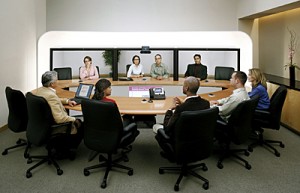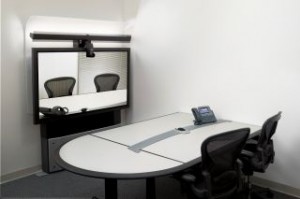A few days ago I participated in an online workshop using Cisco Telepresence technology. While of course I had done videoconferencing many times before, this was my first experience with TP. So, here are a few reflections.
First off, a few details on the event itself. The workshop was organized by the Henley Center for Customer Management and hosted by Cisco. Six Telepresence rooms were participating: one in Barcelona, one in New York, one in Bangalore, and three in London. My role was to share some thoughts on the use of social media/Web 2.0 in the enterprise arena, give a quick update on a Cisco-sponsored research project that we’re currently running, and then join a round-table discussion. The interesting part, though, was that I was to co-present with Neil Hair of RIT who was physically located at Cisco’s New York office. And by “co-present” I mean that the two of us were to use the same PowerPoint file (residing on my laptop in Barcelona) and take turns covering various aspects and complementing each other’s points. Given my prior experiences with videoconferencing, I was a bit worried about how smoothly the whole thing would go (there was this one episode when I was in a videoconference and the two folks on the other end were a Welsh and a Scott. Picture this, a Russian, a Welsh, and a Scott trying to strike up a conversation over a video bridge with a really poor audio connection – anecdote material, isn’t it?).
Well, my concerns turned out to be completely unfounded. Co-presenting over Telepresence felt very natural and neither Neil nor I had any problems jumping into the discussion and going back and forth on various issues. The coolest thing was for Neil in New York to call on myself in Barcelona “Next slide please, Evgeny”. Anyways, when I try to think what made the difference in the TP case vs. regular videoconferencing, it probably comes down to audio latency. There is usually this tiny millisecond audio delay, which doesn’t really matter when there is only one person speaking but it is just enough to spoil things when you need to have a free flowing conversation (this is especially true when there is a single person on one end and a group of folks on the other; the poor guy usually has a really hard time drawing attention to him/herself in order to break into the conversation). With TP there was no such delay whatsoever, meaning that the audio was really real-time. This spared Neil and myself from playing the stupid “you go ahead; no, please you go ahead” game and allowed us to co-present in a very relaxed and natural manner.
If there was one thing that bothered me somewhat throughout the presentation, it was the fact that I couldn’t see the audience. I should acknowledge, though, that this was a limitation of the TP configuration in the Barcelona room (see picture on the right) rather than a shortcoming of the technology in general. Our setup included a single screen that would show only one other TP room at a time. So, for most of the time I was able to see Neil in New York (as he was the one doing the talking on the other end) but not the Henley folks in London. This sure made the interaction between the two of us easier, but to me personally the inability to see how the audience responds created this very awkward sensation of speaking in a vacuum.
To sum up, TP sounds like a great idea for this type of collaborative meetings. I suspect, though, that it comes at a significant cost and many firms, especially in the current business environment, would be reluctant to cash out to gain the luxury of the complete “you are there” meeting experience. Nonetheless, according to Forrester, for global organizations TP may deliver the ROI of 47% or more over the five-year horizon. The benefits come primarily through travel and productivity savings, improvements in employees quality of life, and reduced carbon footprint. Sure, TP hasn’t yet become a mainstay feature of everyday business life in most organizations. Whether, how, and when the tipping point will occur remains to be seen. But in any case, after my recent experience, I personally am looking forward to it.





ive never heard of Telepresence technology so thanks for posting because ive learnt something new and shall go of and see what else i can find.
I was able to see Neil in New York (as he was the one doing the talking on the other end) but not the Henley folks in London. This sure made the interaction between the two of us easier